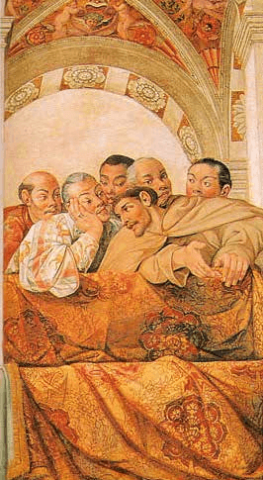Issue:
The recent TPP talks evoke the memory of the earliest attempt at transpacific trade by Japan, launched 400 years ago this October

In the early days of the 17th century, Shogun Tokugawa Ieyasu showed a keen interest in international commerce, a position that gave other powerful men in Japan the incentive to develop their own trade links with far away countries. One was daimyo Date Masamune, the dynamic, fiercely independent and stylish leader of the Date domain in remote Tohoku, far away from Tokugawa spies.
Like Ieyasu, he wanted to promote foreign trade. Enlisting the help of Spanish Christian missionaries, he dispatched a mission that was to proceed to Acapulco, Mexico (then known as Nueva España), thence overland to the Atlantic, where they would take ship to Spain and the final goal of Rome.
The mission leader was Hasekura Tsunenaga, a middle ranking samurai who led the group of warriors, merchants and attendants on board a galleon built to Spanish design at Tsukinoura, near Ishinomaki. The ship’s name was the San Juan Bautista although the locals dubbed it the Date Maru.
On Oct. 28, the brave band set sail, arriving in Acapulco on Jan. 25, 1614.
After trekking across Mexico to Veracruz on the Caribbean coast, the main party sailed via Cuba to Spain, where they changed ships, and eventually reached Rome after further stopovers in Spain and France.
One of the most notable layovers was at the little Spanish town of Coria del Rio, on the Guadalquivir river near Sevilla, where some of the party left significant traces in the form of Japan-Iberian off spring. The children thus born were given the family name of “Japon.”
Today, there are several hundred Spaniards with this historic name descended from Hasekura’s band of visitors. They have formed an association and arranged exchange visits between groups of the Japon families from Spain and citizens of Sendai.
One of Hasekura’s descendants visited Coria del Rio earlier this year as did Japan’s Crown Prince Naruhito, who stopped by in June to help commemorate the 400 years’ connection of the two countries and to plant a cherry tree near a statue of Hasekura in a park by the river.
Another memorable stopover happened on the party’s voyage between Spain and Italy in October 1615. A storm forced their ships to take shelter in the safe haven of St. Tropez bay, where French eye-witnesses reported, “The Japanese never touch food with their hands, but instead use two small sticks that they hold with three fingers.
The impressed witnesses also noted that the samurai “blew their noses in soft silky papers the size of a hand, which they never use twice,” a reference to chirigami. Observers were also awed by the sharpness of the samurai swords, “which could cut paper just by putting it on the edge of the blade and blowing on it. . .”
This short visit in 1615, documented by letters now in an archive in Carpentras, in Provence, is the first recorded instance of Franco Japanese relations, and offers cause for a commemoration in two years’ time. Certainly there should be one in St. Tropez, which can claim to be the first place in Europe to record the use of tissues. Perhaps Kleenex might make an excellent sponsor.
Hasekura’s mission eventually did make it to Rome. Hasekura converted to Christianity, and posed for a fine oil portrait by the French court painter Claude Deruet, a well-known Baroque artist then living in Rome, that remains in the Vatican collection.
But they failed to get the trade deals they wanted. By the time they reached Rome in 1615, reports had arrived from Japan about the savage repressions being forced on Japanese Christians. The bona fides of the mission were also suspect.
After suffering delays and misfortune, Hasekura and a handful of men made it back to Japan via Manila in 1621, to find that Christianity was now savagely condemned. Their few omiyage a handful of rosaries and a portrait of the Pope were not exactly welcome in the new environment.
Hasekura died of illness in 1622. It is not known if he renounced his Christian faith before he passed away.
Although Hasekura and his band had had left their mark in Europe in several ways, all knowledge in Japan of their heroic journey was forgotten, if not suppressed, for hundreds of years. When the Meiji period Iwakura Mission members visited Italy in 1873, they were shown old documents describing the events and interest in the old story was revived.
Today three temples in the area claim to be Hasekura’s last resting place. A few religious trinkets thought to have belonged to him survive in a Sendai museum.
Award winning writer Shusaku Endo’s acclaimed 1981 novel, The Samurai, provides a dramatic fictional account of the mission and Hasekura’s dilemma as a Christian convert in resolving his loyalty to Christ, his spiritual master, and his earthly lord, Date Masamune.
Geoff Tudor writes for Orient Aviation, Hong Kong. He is the Assistant Editor of the No. 1 Shimbun.
GALLEON FIX
A full size replica of the San Juan Bautista St. John the Baptist is proudly displayed in a marine park in Ishinomaki City, not far from where the original galleon set sail in Oct. 1613.
Two of its three masts were damaged beyond repair in the 3.11 disaster. No suitable timber was available in Japan to replace the damaged parts, and museum minders thought of using aluminium.
Hearing of the problem, a Canadian forestry company donated five giant logs for reconstruction, ensuring that the vessel would be fully ship shape by the 400th year of its ancestor’s maiden transpacific voyage. After four centuries, the merits of foreign trade have come home to Date’s domain.

